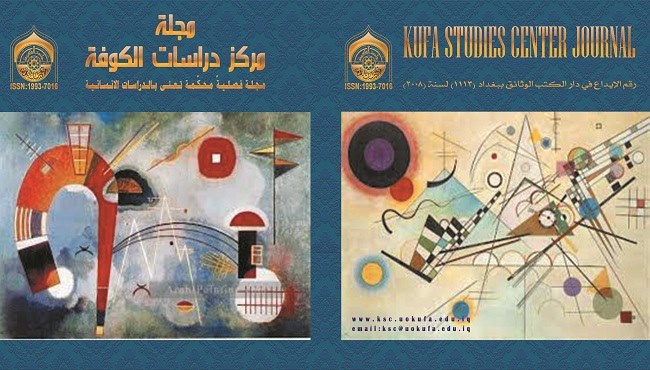أثر البيئة الثقافية والطبيعية كمحفزات في تشكيل وصياغة النسيج الحضري مثال تحليلي للفترة السومرية من حضارة وادي الرافدين
DOI:
https://doi.org/10.36322/jksc.v1i53.5041Abstract
النسيج الحضري هو المرآة والوثيقة التي تعكس تفاعل الانسان مع البيئة ضمن مكان وزمان محددين، فينتج عن هذا التفاعل تكوينات حضرية من فضاءات يمارس فيها الانسان نشاطاته اليومية سواء كانت هذه الفضاءات داخلية المتمثلة بالكتل البنائية او فضاءات خارجية تتمثل بالفضاءات المفتوحة بمختلف أنواعها. سعى البحث الى توضيح الرؤيا الشمولية لأهمية هاتين البيئتين من خلال الاعتماد على منهج تحليلي واستقصائي تضمن العودة الى جذور النسيج الحضري المتمثل بالفترة السومرية من حضارة وادي الرافدين، والناتج من تفاعل الانسان مع البيئة ومحاولة الاستفادة منه كونه المرآه والذاكرة الجمعية ضمن المكان والزمان والمولد والمحفز للتطور والرؤيا المستقبلية وكون هذه الفترة قد اسست النواة الأولى في التحضر الإنساني. لذلك سيتم مناقشة الدور الذي لعبته عوامل البيئة الثقافية والطبيعية في تشكيل النسيج الحضري لمدن هذه الحضارة كحالة دراسية وتحليلية لاختبار أهمية هاتين البيئتين. وتوصل البحث الى ان التأكيد على أهمية البيئة الثقافية والطبيعية لا تعني إعادة الموروث من خلال الرجوع الى النسيج التقليدي وانما من دراسة وتحليل الأنظمة والمعالجات الحضرية الخاصة بالنسيج الحضري التقليدي والناتجة من تفاعل الانسان مع البيئة من خلال ادراكها والاستفادة منها في تطوير أنظمة النسيج الحضري ومعالجاته عن طريق الاستعانة بمعطيات التكنلوجيا الحديثة والبرامج العلمية المتطورة وذلك لإعادة تقييم وتطوير بنية النسيج الحضري مما يولد رؤيا متجدده ومعاصرة له تعزز من قيم الهوية والخصوصية المحلية وتقوي اصرة الانتماء ضمن المكان والزمان .
Urban fabric is the mirror and document that reflect the interaction of man with the environment within a specific place and time, resulting in the interaction of urban configurations of spaces in which man exercises his daily activities, whether these internal spaces of building blocks or outer spaces are open spaces of various kinds. And the interaction of man with the environment within a specific time and place result in achieving the urban identity of that place. The interaction of the human with its cultural and natural environment is what makes the urban fabric distinct from the other and in the same Time gives a sense of being familiar and promotes belonging to it, whether on the level of buildings, spaces or paths, thus strengthening the identity and authenticity of the city. The research sought to clarify the holistic vision of the importance of these two environments by relying on an analytical and exploratory approach that ensures the return to the roots of the urban fabric represented by the Sumerian period of the Mesopotamian civilization, resulting from human interaction with the environment and the attempt to benefit from it. And the fact that this period has established the first nucleus of human civilization. Therefore, the role played by cultural and natural environment factors in shaping the urban fabric of the cities of this civilization will be discussed as a case study and analysis to test the importance of these two environments. The study concluded, that the emphasis on the importance of the cultural and natural environment does not mean the return of the heritage through reference to the traditional fabric, but from the study and analysis of urban systems and treatments of the traditional urban fabric, which is resulting from human interaction with the environment, through its understanding and use in the development of urban textile systems and treatments by The use of modern technology and advanced scientific programs to re-evaluate and develop the structure of the urban fabric, which generates a renewed and contemporary vision that promotes the values of identity and local privacy and strengthen the sense of belonging within the space and time.
Downloads
Downloads
Published
How to Cite
Issue
Section
License
Copyright (c) 2022 مجلة مركز دراسات الكوفة | Journal of Kufa Studies Center

This work is licensed under a Creative Commons Attribution 4.0 International License.
Permit others to distribute and copy the manuscript, to create extracts, abstracts, and other revised versions, adaptations, or derivative works of or from the manuscript (such as a translation), to include in a collective work, to text or data mine the article, even for commercial purposes, as long as they credit the author(s), do not represent the author as endorsing their adaptation of the article, and do not modify the article in such a way as to damage the author''''s honor or reputation. Further details are found at Creative Commons Attribution 4.0 International (CC BY 4.0)






























